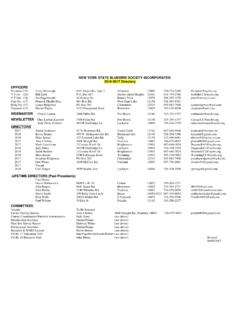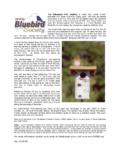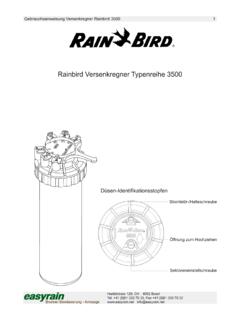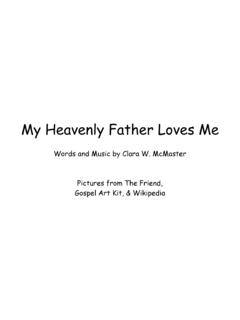Transcription of BE PATIENT - NYSBS
1 BLUEBIRD NESTING BOXES 4. Where raccoons are common, a 3/4 in. thick wooden predator guard with the same 1 1/2 in. opening mounted over the entry hole may help somewhat. A much greater level of protection will be provided by covering the metal pipe support with a thick grease. 5. Face the opening of the nesting box away from the prevailing wind and towards a tree or shrub 25 to 100 ft. away if possible for a landing area when fledglings first leave the nest 6. Do not alter the size of the entrance: 1 1/2 in. is correct for bluebirds. Larger entrances attract starlings. Less than 1 1/2 in. (1 3/8 in. or less) is too small for bluebirds to enter. 7. If you do paint or stain a nesting box, use a light color and apply it only on the outside of the nesting boxes. This will keep the inside temperatures as much as 12-18 degrees cooler in the summer than a dark stain.
2 Do not stain or paint the inside of nesting box or the entrance. Leaving the nesting box a natural wood color is also acceptable. 8. Do not add a perch to the nesting box. Perches allow more harassment from sparrows and starlings, which will light on the perch. WHERE TO LOCATE BLUEBIRD NESTING BOXES HOMES, LAWN AREAS: 1. Bluebirds prefer large lawns with short grasses because they primarily feed on insects found on the ground. 2. Locate boxes on the outside perimeter of lawns away from areas of activity. 3. Locate boxes in open areas with a scattering of trees or shrubs nearby for perching. 4. It's nice to locate the nesting box where it can be observed from a house window so you can enjoy the day-to-day activities of the bluebirds. 5. Locating several nesting boxes on the same lawn will not invite more than 1 pair of bluebirds.
3 A pair of bluebirds will establish a territory during the nesting season and will allow no other bluebirds in the immediate area. One nesting box in the right area is all that is needed, except that it is desirable to pair it with a second box for tree swallows. We recommend at least 100 yards between nesting box pairs. This is the size of the territory from which bluebirds will exclude other bluebirds. WHERE TO LOCATE BLUEBIRD NESTING BOXES - OPEN COUNTRYSIDE AREAS: 1. Bluebirds prefer to nest in boxes located in open field areas with a scattering of trees, shrubs, and fences. 2. Locate boxes in an open area along hay fields, pastures, etc. where grasses are short. Cows and horses may damage nesting boxes on fence lines. Use a rugged box that has been reinforced or locate the box out of reach a few feet away from the fence.
4 3. Locating the nesting box in a brushrow along an open field is acceptable if it is in an open area in the brushrow. Excessively brushy areas attract wrens. 4. Locating a nesting box on an "island" in hay field (caused by rock outcrops, stump, etc.) is ideal, if not too dense with shrubs or trees. 5. Abandoned orchards are favorable bluebird haunts. BE PATIENT . You may not attract bluebirds the first year. As the population increases you may have more success in the future. MOUNTING INSTRUCTIONS : 1. Mount nesting boxes early in the spring; males begin arriving in mid-March. 2. A 6 to 6 1/2 ft. length of 3/4 in. pipe is recommended. Use an a-bolt so height and direction can be varied. 3. The base of the nesting box should be approximately 4-5 ft. above the ground. WHERE NOT TO LOCATE BLUEBIRD NESTING BOXES 1.
5 DO NOT locate a bluebird nesting box in a large village, except perhaps on the outer fringes. The populations of bluebirds are low in villages due to the high population of sparrows and starlings there that drive them away. 2. DO NOT locate boxes by well-traveled pedestrian areas or too near a well-traveled highway. 3. DO NOT locate nesting-boxes on the trunk of a tree. 4. DO NOT locate a box directly under the canopy of a tree. Locate in sunny areas. 5. DO NOT locate nesting boxes on the dike of a pond. This invites more tree swallows. 6. DO NOT locate boxes in brushy fields or within 50 feet of a woods. This invites house wrens. 7. DO NOT locate near barns or other outbuildings. This invites sparrows. 8. DO NOT mount boxes where insecticides are used extensively. COMPETITION FROM OTHER BIRDS FOR NESTING BOXES: 1.
6 TREE SWALLOWS - The most effective control to help eliminate competition from tree swallows is to locate two nesting boxes in a pair approximately 5 ft. apart. Often tree swallows will use the second box. If located at a greater distance, tree swallows may occupy both boxes. They aren't as territorial as bluebirds. 2. HOUSE (ENGLISH) SPARROWS - Locate boxes away from outbuildings and old barns that sparrows frequent. Keep the nesting box only 4-5 ft. above ground level. Sparrows prefer to nest at a higher level. The house sparrow population is becoming higher each year because people are allowing them to nest in bluebird boxes. House sparrows were a severe problem in recent years and caused bluebird nesting failures in numerous boxes, cutting drastically into our bluebird population. If sparrows want to nest in an occupied bluebird nesting box they will destroy the bluebird eggs or kill the bluebird fledglings and even kill the female bluebird on the nest.
7 If you wish to help in the recovery of the bluebird, it is essential that you monitor your nesting boxes and control the house sparrow. Unlike all native songbirds, house sparrows and starlings are not protected species and you may deal with them any way you wish. One method of control you may use is to remove the sparrow nest each morning as they build. Never allow the house sparrow to complete a nesting in any of your nesting boxes. 3. WRENS - Keep nesting boxes away from woods and brushy areas. If a wren wants a nesting box occupied by a pair of bluebirds, the wren will peck holes in the eggs or kill the fledglings causing the bluebirds to leave. 4. STARLINGS - If the entrance to the box is kept exactly 1 1/2" starlings cannot enter. PREDATORS AND OTHER PROBLEMS 1. THE HOUSE CAT - That "innocent looking" house cat is a vicious predator of the bluebird.
8 The bluebird is a ground feeder and thus easy prey for cats. A cat will occasionally leap up to boxes if located too near ground level. If cats are a problem, raise the box to 6 ft. Also, attach a bell to the cat's collar to warn the birds of its presence. Keep cats indoors when fledglings are about to leave the nest. 2. RACCOONS - Research conducted at SUNY Cobleskill under controlled conditions has proven that raccoons can readily climb even smooth metal or PVC pipes. Greased pipe appears to deter raccoons from climbing to the box. If you are not able to use a greased pipe mount, a nesting box with a roof overhanging the entry hole by 5 in. appears to retard entry by raccoons from the box top. 3. RED SQUIRRELS - Locate nesting boxes away from the woods, particularly evergreen forests. 4. BLOWFLY LARVAE - A serious problem in recent years.
9 After fledglings hatch, check every 3 to 4 days for fly larvae. Lift the nest and check the floor of the box. It fly larvae (tan, 3/8 in. long) are in evidence, remove the nest, clean the box, and make a new nest of dead grass or dried lawn clippings and return the fledglings. Bluebirds do not object: songbirds have a very poor sense of smell. 5. WASPS - Remove (very carefully) 6. WHITE-FOOTED/DEER MICE - Mice often build nests in nesting boxes, particularly in the winter months, and must be removed each spring. To control mice in boxes with pipe supports, use heavy grease on a section and they will be unable to climb. 7. WET NESTS - After a prolonged or driving rain check your nesting boxes. The nest often becomes damp or wet. It young nestlings are in a wet nest they may develop respiratory problems or hypothermia, and you may lose them.
10 Remove the wet nest, build a new nest of dried lawn clippings or fine dried grass and return the nestlings. Keep the new nest the same height as the original one. SETTING UP A TRAIL: Bluebirds are highly territorial and only one pair will nest in an area during the mating and nesting period. On a trail, locate the nesting box pairs a minimum of 100 yards apart from the adjacent pair. Locate nesting boxes only in ideal places. Ask permission of landowners. MAINTENANCE: 1. Clean out old nesting material from previous year in the spring. 2. Regrease sections of metal pipes supporting boxes periodically. 3. Check nesting box every four to seven days. However, do not open side or front opening boxes after nestlings are 12 days old since this might cause them to leave the nest prematurely. 4. Remove nest after each brood leaves the nest.







